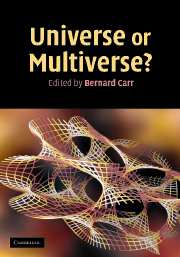Book contents
- Frontmatter
- Contents
- List of contributors
- Preface
- Acknowledgements
- Editorial note
- Part I Overviews
- Part II Cosmology and astrophysics
- Part III Particle physics and quantum theory
- Part IV More general philosophical issues
- 20 Scientific alternatives to the anthropic principle
- 21 Making predictions in a multiverse: conundrums, dangers, coincidences
- 22 Multiverses: description, uniqueness and testing
- 23 Predictions and tests of multiverse theories
- 24 Observation selection theory and cosmological fine-tuning
- 25 Are anthropic arguments, involving multiverses and beyond, legitimate?
- 26 The multiverse hypothesis: a theistic perspective
- 27 Living in a simulated universe
- 28 Universes galore: where will it all end?
- Index
- References
20 - Scientific alternatives to the anthropic principle
Published online by Cambridge University Press: 05 July 2014
- Frontmatter
- Contents
- List of contributors
- Preface
- Acknowledgements
- Editorial note
- Part I Overviews
- Part II Cosmology and astrophysics
- Part III Particle physics and quantum theory
- Part IV More general philosophical issues
- 20 Scientific alternatives to the anthropic principle
- 21 Making predictions in a multiverse: conundrums, dangers, coincidences
- 22 Multiverses: description, uniqueness and testing
- 23 Predictions and tests of multiverse theories
- 24 Observation selection theory and cosmological fine-tuning
- 25 Are anthropic arguments, involving multiverses and beyond, legitimate?
- 26 The multiverse hypothesis: a theistic perspective
- 27 Living in a simulated universe
- 28 Universes galore: where will it all end?
- Index
- References
Summary
Introduction
I have chosen a deliberately provocative title, in order to communicate a sense of frustration I have felt for many years about how otherwise sensible people, some of whom are among the scientists I most respect and admire, espouse an approach to cosmological problems — the Anthropic Principle (AP) — that is easily seen to be unscientific. By calling it unscientific I mean something very specific, which is that it lacks a property necessary for any scientific hypothesis — that it be falsifiable. According to Popper [1—4], a theory is falsifiable if one can derive from it unambiguous predictions for practical experiments, such that — were contrary results seen — at least one premise of the theory would have been proven not to true. This introduction will outline my argument in a few paragraphs. I will then develop the points in detail in subsequent sections.
While the notion of falsifiability has been challenged and qualified by philosophers since Popper, such as Kuhn, Feyerabend and others, few philosophers of science or working scientists would be able to take seriously a fundamental theory of physics that had no possibility of being disproved by an experiment. This point is so basic to how science works that it is perhaps worthwhile taking a moment to review its rationale.
- Type
- Chapter
- Information
- Universe or Multiverse? , pp. 323 - 366Publisher: Cambridge University PressPrint publication year: 2007
References
- 11
- Cited by



